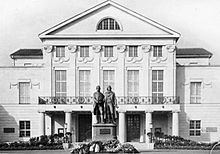Type Constituent Assembly Dates 6 Feb 1919 – 6 Jun 1920 Established 1919 Disbanded 1920 | Preceded by Imperial Reichstag Last election 19 January 1919 Seats 421 Succeeded by Weimar Reichstag | |
 | ||
Voting system Direct competitive elections | ||
The Weimar National Assembly (German: Weimarer Nationalversammlung) was the constitutional convention and de facto parliament of Germany from 6 February 1919 to 6 June 1920. It drew up the new constitution which was in force from 1919 to 1933, technically remaining in effect even until the end of Nazi rule in 1945. It convened in Weimar, Thuringia and is the reason for this period in German history becoming known as the Weimar Republic.
Contents
Background
With the end of the First World War and the start of the November Revolution, Chancellor Max of Baden announced the abdication of the German Emperor Wilhelm II on 9 November 1918. He also appointed Friedrich Ebert as his own successor as Chancellor. The Council of the People's Deputies, a provisional government consisting of three delegates from the Social Democratic Party (SPD) and three from the Independent Social Democratic Party (USPD), took over the executive power on the following day and called for a National Congress of Councils on 16 to 21 December to convene in Berlin. This Reichsrätekongress set elections for a national assembly to take place on 19 January 1919.
Elections
The elections for the National Assembly on 19 January 1919 were the first elections in Germany after the introduction of women's suffrage. The legal voting age had been lowered from 25 to 20 years. Together, these changes raised the number of eligible voters by around 20 million. The turnout rate was 83%, a slightly lower percentage than in the last Reichstag elections in 1912, but a much greater absolute turnout due to the expanded suffrage. Among women the turnout was 90%.
The election yielded a 38% plurality for the SPD, with the Center Party (Zentrum) getting 20% of the votes, the German Democratic Party (DDP) over 18%, the right-wing German National People's Party (DNVP) just over 10%, and the Independent Social Democrats (USPD) over 7%. The German People's Party (DVP), Bavarian Peasants' League (BB), German-Hanoverian Party (DHP), Schleswig-Holsteinische Bauern- und Landarbeiterdemokratie (SHBLD), and Brunswick Election-Union (BLWV) each attained less than five percent of the vote. The Communist Party, founded in December 1918, boycotted the elections. Although SPD and USPD had been instrumental in introducing women's suffrage, most women voted for the DDP and DNVP (in Protestant parts of the country) or the Zentrum or BVP (in Catholic parts). The parties were attributed a number of seats proportional to the number of votes they received. Out of a total of 416 delegates just 37 were women. The so-called "Weimar Coalition" of SPD, Centre Party and DDP held an absolute majority of the seats.
Establishment
The National Assembly met in Weimar for several reasons: the politicians wanted to avoid the ongoing fights in the capital Berlin, and SPD leader Friedrich Ebert wanted to remind the victorious World War I Allies, who were at the time deliberating a peace treaty, of Weimar Classicism, which included the likes of Goethe and Schiller.
Important events and decisions
Dissolution
On 21 May 1920 the National Assembly dissolved itself. After the first elections based on the new constitution took place on 6 June 1920, the Reichstag took over the role of the National Assembly.
